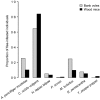Multihost Bartonella parasites display covert host specificity even when transmitted by generalist vectors
- PMID: 27380876
- PMCID: PMC5082552
- DOI: 10.1111/1365-2656.12568
Multihost Bartonella parasites display covert host specificity even when transmitted by generalist vectors
Abstract
Many parasites infect multiple sympatric host species, and there is a general assumption that parasite transmission between co-occurring host species is commonplace. Such between-species transmission could be key to parasite persistence within a disease reservoir and is consequently an emerging focus for disease control. However, while a growing body of theory indicates the potential importance of between-species transmission for parasite persistence, conclusive empirical evidence from natural communities is lacking, and the assumption that between-species transmission is inevitable may therefore be wrong. We investigated the occurrence of between-species transmission in a well-studied multihost parasite system. We identified the flea-borne Bartonella parasites infecting sympatric populations of Apodemus sylvaticus (wood mice) and Myodes glareolus (bank voles) in the UK and confirmed that several Bartonella species infect both rodent species. However, counter to previous knowledge, genetic characterization of these parasites revealed covert host specificity, where each host species is associated with a distinct assemblage of genetic variants, indicating that between-species transmission is rare. Limited between-species transmission could result from rare encounters between one host species and the parasites infecting another and/or host-parasite incompatibility. We investigated the occurrence of such encounter and compatibility barriers by identifying the flea species associated with each rodent host, and the Bartonella variants carried by individual fleas. We found that the majority of fleas were host-generalists but the assemblage of Bartonella variants in fleas tended to reflect the assemblage of Bartonella variants in the host species they were collected from, thus providing evidence of encounter barriers mediated by limited between-species flea transfer. However, we also found several fleas that were carrying variants never found in the host species from which they were collected, indicating some degree of host-pathogen incompatibility when barriers to encounter are overcome. Overall, these findings challenge our default perceptions of multihost parasite persistence, as they show that despite considerable overlaps in host species ecology, separate populations of the same parasite species may circulate and persist independently in different sympatric host species. This questions our fundamental understanding of endemic transmission dynamics and the control of infection within natural reservoir communities.
Keywords: Apodemus sylvaticus; Bartonella; Myodes glareolus; fleas; host-generalist; host-specialist; pathogen genotypes; rodents; sequencing; vector-borne diseases.
© 2016 The Authors. Journal of Animal Ecology published by John Wiley & Sons Ltd on behalf of British Ecological Society.
Figures





References
-
- Begon, M. , Bowers, R.G. , Kadiankis, N. & Hodgkinson, D.E. (1992) Disease and community structure: the importance of host self‐regulation in a host‐host‐pathogen model. The American Naturalist, 139, 1131–1150.
-
- Berglund, E.C. , Ellegaard, K. , Granberg, F. , Xie, Z. , Maruyama, S. , Kosoy, M. et al (2010) Rapid diversification by recombination in Bartonella grahamii from wild rodents in Asia contrasts with low levels of genomic divergence in Northern Europe and America. Molecular Ecology, 19, 2241–2255. - PubMed
-
- Birtles, R. , Hazel, S. , Bown, K. , Raoult, D. , Begon, M. & Bennett, M. (2000) Subtyping of uncultured bartonellae using sequence comparison of 16 S/23 S rRNA intergenic spacer regions amplified directly from infected blood. Molecular and Cellular Probes, 14, 79–87. - PubMed
Publication types
MeSH terms
Substances
Associated data
Grants and funding
LinkOut - more resources
Full Text Sources
Other Literature Sources

